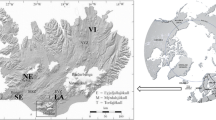Abstract
An allozyme survey, using starch-gel electrophoresis, was carried out on eight populations of the Antarctic nemertean worm Parborlasia corrugatus (McIntosh, 1876) collected from locations around the South Orkney Islands, Antarctica. These populations were separated by distances in the order of tens of kilometres. Genetic variation was estimated over 22 enzyme loci for all populations examined, giving an observed heterozygosity of 0.142. This was much lower than the expected heterozygosity (H e = 0.201), and it was found that there was a significant deficiency of het‐erozygotes across four enzyme loci ( p ≤ 0.01). A more detailed examination of this deficiency of heterozygotes was undertaken for the six populations and six variable enzyme loci for which the most complete data sets existed. A significant deficiency of heterozygotes was found at the enzyme locus Odh-1 for four of the six populations examined ( p ≤ 0.01). Mean F is (0.240) indicated a significant ( p ≤ 0.01) within-population component of the heterozygote deficiency estimated for the six populations sampled, and this was mainly due to the␣Ap-1, Odh-1 and Pgm-1 loci. The mean F st value (0.036) was also significant ( p ≤ 0.01), indicating a degree of genetic differentiation between populations. The observed levels of genetic differentiation between populations of P. corrugatus and the significant heterozygote deficiencies were unexpected, because this species has been reported to have a long-lived planktotrophic larva. It is hypothesised that recruitment of P. corrugatus in the South Orkney Islands originates from genetically distinct populations located in the Weddell Sea and to the west of the Antarctic Peninsula. Shifts in the relative position of the Weddell Sea Front, Weddell–Scotia Confluence and Scotia Front, relative to the South Orkney Islands, provide a mechanism for variation in the origin of recruits over time.
Similar content being viewed by others
Author information
Authors and Affiliations
Additional information
Received: 24 July 1997 / Accepted: 31 October 1997
Rights and permissions
About this article
Cite this article
Rogers, A., Clarke, A. & Peck, L. Population genetics of the Antarctic heteronemertean Parbolasia corrugatus from the South Orkney Islands. Marine Biology 131, 1–13 (1998). https://doi.org/10.1007/s002270050290
Issue Date:
DOI: https://doi.org/10.1007/s002270050290



